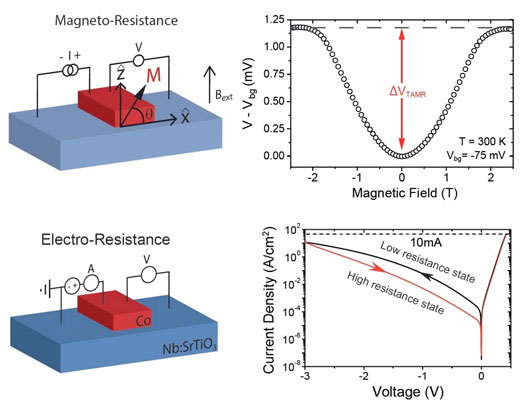| Posted: Jan 22, 2018 |
New metal-semiconductor interface for brain-inspired computing
(Nanowerk News) One of the big challenges in computer architecture is integrating storage, memory and processing in one unit. This would make computers faster and more energy efficient. University of Groningen physicists have taken a big step towards this goal by combining a niobium doped strontium titanate (SrTiO3) semiconductor with ferromagnetic cobalt. At the interface, this creates a spin-memristor with storage abilities, paving the way for neuromorphic computing architectures. The results were published in Scientific Reports ("Large room-temperature tunneling anisotropic magnetoresistance and electroresistance in single ferromagnet/Nb:SrTiO3 Schottky devices").
|
|
The device developed by the physicists combines the memristor effect of semiconductors with a spin-based phenomenon called tunnelling anisotropic magnetoresistance (TAMR) and works at room temperature. The SrTiO3 semiconductor has a non-volatile variable resistance when interfaced with cobalt: an electric field can be used to change it from low to high resistance and back. This is known as the electroresistance effect.
|
 |
| TAMR and electroresistance in aniobium doped strontium titanate (SrTiO3) semiconductor with ferromagnetic cobalt Top left: a simple device of Co on Nb doped SrTiO3 oxide semiconductor and the four-probe measurement scheme. Top right: a large TAMR value is obtained at room temperature due to a change in the junction tunnel conductance when the magnetization is rotated in respect to the direction of the current flow. Bottom left: the same device geometry is used to study the electroresistance state of the same junction (bottom right). (Image: Banarjee group, University of Groningen)
|
Tunability
|
|
Furthermore, when a magnetic field was applied across the same interface, in and out of the plane of the cobalt, this showed a tunablity of the TAMR spin voltage by 1.2 mV. This coexistence of both a large change in the value of TAMR and electroresistance across the same device at room temperature has not previously been demonstrated in other material systems.
|
|
'This means we can store additional information in a non-volatile way in the memristor, thus creating a very simple and elegant integrated spin-memristor device that operates at room temperature', explains Professor of Spintronics of Functional Materials Tamalika Banerjee. She works at the Zernike Institute for Advanced Materials at the University of Groningen. So far, attempts to combine spin-based storage, memory and computing have been hampered by a complex architecture in addition to other factors.
|
Brain
|
|
The key to the success of the Banerjee group device is the interface between cobalt and the semiconductor. 'We have shown that a one-nanometre thick insulating layer of aluminium oxide makes the TAMR effect disappear', says Banerjee. It took quite some work to engineer the interface. They did so by adjusting the niobium doping of the semiconductor and thus the potential landscape at the interface. The same coexistence can't be realized with silicon as a semiconductor: 'You need the heavy atoms in SrTiO3 for the spin orbit coupling at the interface that is responsible for the large TAMR effect at room temperature.'
|
|
These devices could be used in a brain-like computer architecture. They would act like the synapses that connect the neurons. The synapse responds to an external stimulus, but this response also depends on the synapse's memory of previous stimuli. 'We are now considering how to create a bio-inspired computer architecture based on our discovery.' Such a system would move away from the classical Von Neumann architecture. The big advantage is that it is expected to use less energy and thus produce less heat. 'This will be useful for the "Internet of Things", where connecting different devices and networks generates unsustainable amounts of heat.'
|
Energy efficiency
|
|
The physics of what exactly happens at the interface of cobalt and the strontium semiconductor is complicated, and more work needs to be done to understand this. Banerjee: 'Once we understand it better, we will be able to improve the performance of the system. We are currently working on that. But it works well as it is, so we are also thinking of building a more complex system with such spin-memristors to test actual algorithms for specific cognition capabilities of the human brain.' Banerjee's device is relatively simple. Scaling it up to a full computing architecture is the next big step.
|
|
How to integrate these devices in a parallel computing architecture that mimics the working of the brain is a question that fascinates Banerjee. 'Our brain is a fantastic computer, in the sense that it can process vast amounts of information in parallel with an energy efficiency that is far superior to that of a supercomputer.' Banerjee's team's findings could lead to new architectures for brain-inspired computing.
|

